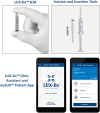Implantation of a novel insertable cardiac monitor: preliminary multicenter experience in Europe
- PMID: 38755520
- PMCID: PMC11711855
- DOI: 10.1007/s10840-024-01821-y
Implantation of a novel insertable cardiac monitor: preliminary multicenter experience in Europe
Abstract
Background: The LUX-Dx™ is a novel insertable cardiac monitor (ICM) introduced into the European market since October 2022.
Purpose: The aim of this investigation was to provide a comprehensive description of the ICM implantation experience in Europe during its initial year of commercial use.
Methods: The system comprises an incision tool and a single-piece insertion tool pre-loaded with the small ICM. The implantation procedure involves incision, creation of a device pocket, insertion of the ICM, verification of sensing, and incision closure. Patients receive a mobile device with a preloaded App, connecting to their ICM and transmitting data to the management system. Data collected at European centers were analyzed at the time of implantation and before patient discharge.
Results: A total of 368 implantation procedures were conducted across 23 centers. Syncope (235, 64%) and cryptogenic stroke (34, 9%) were the most frequent indications for ICM. Most procedures (338, 92%) were performed in electrophysiology laboratories. All ICMs were successfully implanted in the left parasternal region, oriented at 45° in 323 (88%) patients. Repositioning was necessary after sensing verification in 9 (2%) patients. No procedural complications were reported, with a median time from skin incision to suture of 4 min (25th-75th percentiles 2-7). At implantation, the mean R-wave amplitude was 0.39 ± 0.30 mV and the P-wave visibility was 91 ± 20%. Sensing parameters remained stable until pre-discharge and were not influenced by patient characteristics or indications. Procedural times were fast, exhibited consistency across patient groups, and improved after an initial experience with the system. Operator Operator feedback on the system was positive. Patients reported very good ease of use of the App and low levels of discomfort after implantation.
Conclusions: LUX-Dx™ implantation appears efficient and straightforward, with favorable post-implantation sensing values and associated with positive feedback from operators and patients.
Keywords: Arrhythmias; Atrial fibrillation; Cryptogenic stroke; Implantation; Insertable cardiac monitor; Loop recorder; Syncope.
© 2024. The Author(s).
Conflict of interest statement
Declarations. Conflict of interest: This was an independent study. No external funding was received for this project. M.C. and S.V. are employees of Boston Scientific. The other authors report no conflicts.
Figures



References
-
- Brignole M, Moya A, de Lange FJ, Deharo JC, Elliott PM, Fanciulli A, Fedorowski A, Furlan R, Kenny RA, Martín A, Probst V, Reed MJ, Rice CP, Sutton R, Ungar A, van Dijk JG, ESC Scientific Document Group. 2018 ESC Guidelines for the diagnosis and management of syncope. Eur Heart J. 2018;39:1883–948. - PubMed
-
- Sakhi R, Theuns DAMJ, Szili-Torok T, Yap SC. Insertable cardiac monitors: current indications and devices. Expert Rev Med Devices. 2019;16:45–55. - PubMed
-
- Varma N, Cygankiewicz I, Turakhia MP, Heidbuchel H, Hu YF, Chen LY, Couderc JP, Cronin EM, Estep JD, Grieten L, Lane DA, Mehra R, Page A, Passman R, Piccini JP, Piotrowicz E, Piotrowicz R, Platonov PG, Ribeiro AL, Rich RE, Russo AM, Slotwiner D, Steinberg JS, Svennberg E. 2021 ISHNE/HRS/EHRA/APHRS expert collaborative statement on mHealth in arrhythmia management: digital medical tools for heart rhythm professionals: from the International Society for Holter and Noninvasive Electrocardiology/Heart Rhythm Society/European Heart Rhythm Association/Asia-Pacific Heart Rhythm Society. Circ Arrhythm Electrophysiol. 2021;14:e009204. - PMC - PubMed
Publication types
MeSH terms
LinkOut - more resources
Full Text Sources

